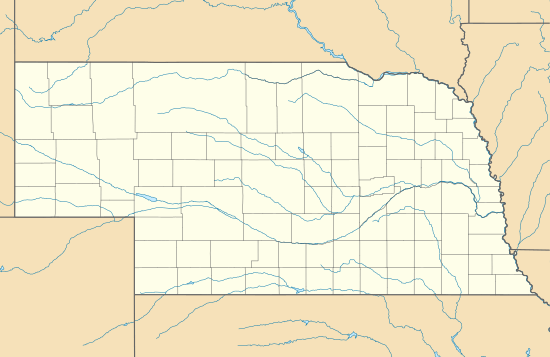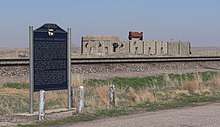Antioch, Nebraska
Antioch is a ghost town in Sheridan County, Nebraska, United States. Located approximately 15 miles east of Alliance on Nebraska Highway 2, the town was once nicknamed "the potash capital of Nebraska."[2] The town took its name from Antioch, Ohio.[3]
Antioch, Nebraska | |
|---|---|
 Ruins of potash plant near Antioch | |
 Antioch, Nebraska Location within the state of Nebraska | |
| Coordinates: 42°04′06″N 102°34′56″W[1] | |
| Country | United States |
| State | Nebraska |
| County | Sheridan |
| Elevation | 3,881 ft (1,183 m) |
| Time zone | UTC-6 ([MST]) |
| • Summer (DST) | MST |
| Area code(s) | 308 |
| GNIS feature ID | 834979 |
History
Antioch is located in the sparsely-populated Sandhills region of western Nebraska. According to one historian, the year before the United States became involved in World War I, the town only had one schoolhouse, a church, and a store.
In 1917, scientists at the University of Nebraska introduced a method of distilling potash from the water of alkali lakes which dotted the Sandhills.[4][5][6] Potash had been primarily imported from Germany prior to World War I.[7] German potash had sold for around $8 to $10 per ton, but scarcity during the war drove the price of potash to $150 a ton.[7]
Antioch's proximity to several major alkali lakes made it the logical home of five potash reduction factories: the American, Nebraska, Alliance, National, and Western potash companies.[4] All these companies were major suppliers of potash during World War I. With the factories came work and by spring of 1918, Antioch had grown into a small city with a population of over 5,000 people.[5][6]
The potash from Antioch was used during the war in the production of fertilizer, Epsom Salts, soda, and other products.[6] The land on which the factories in Antioch had been built were state-owned, and the government's leasing them to private companies attracted public scrutiny.[7] To combat the rumors of favoritism, the Nebraska Secretary of State and Nebraska State Land Commissioner issued a press release claiming that they had leased the land privately rather than publicly to avoid delay because "our country needs the product for munitions."[7] Potash was not used in munitions, but the public generally accepted the falsehood as fact.[7]

When Germany and France resumed trade with the United States in 1921, the potash trade was decimated.[6] German and French potash was cheaper to produce than Nebraska potash and thus destroyed the market for American-made potash.[6] The factories immediately closed.[2] The machinery was sold for scrap; the factories were demolished for the salvage value of the building materials; and the company housing was torn down or moved. Only the foundations of the factories and of some of the larger houses remained.[8] Today, Antioch has fewer than 25 residents.
In 1979, the remains of Antioch's potash plants were added to the National Register of Historic Places,[9] and a historical marker can be found west of what remains of Antioch commemorating the factories and boomtown.[6][7]
References
- Geographic Names Information System Feature Detail Report. Geographic Names Information System. 2000-01-01. Retrieved 2010-10-03.
- Hickey, Donald R.; Wunder, Susan A.; Wunder, John R. (2007). Nebraska Moments. U of Nebraska Press. p. 165. ISBN 0-8032-1572-X.
- Federal Writers' Project (1938). Origin of Nebraska place names. Lincoln, NE: Works Progress Administration. p. 5.
- "The Great WWI Potash Industry of Southern Sheridan County, Nebraska" Archived 2011-07-16 at the Wayback Machine Sheridan County Historical Society. p. 2. Retrieved Sept. 25, 2010.
- (1919) The American Missionary. Volume 73. Congregational Home Missionary Society, American Missionary Association.
- "Antioch: Potash boom town". Nebraska State Historical Society. Retrieved Sept. 25, 2010.
- "The Ruins along Highway 2". History Nebraska. Retrieved 2018-10-19.
- Jensen, Richard E. "National Register of Historic Places Inventory--Nomination Form: Antioch Potash Plants". Nebraska State Historical Society. Retrieved 2013-10-18.
- "Nebraska National Register Sites in Sheridan County". Nebraska State Historical Society. Retrieved 2013-10-18.
External links
- "The Great WWI Potash Industry of Southern Sheridan County, Nebraska" Sheridan County Historical Society.
- "Antioch, Nebraska" on Ghosttowns.com
- Antioch Graveyard photo from NebraskaGravestonres.org